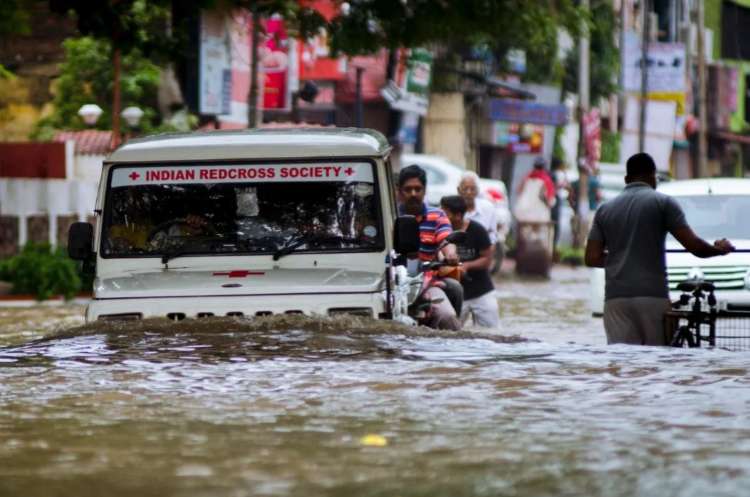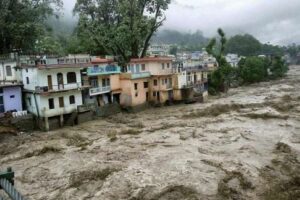
Extreme weather events test climate resilience: Climate change is once again in the headlines, this time for the devastation in Uttarakhand’s Mussoorie and the flooding of large parts of Kolkata. The spectacle of hill towns cut off by landslides and a metro city paralysed by waterlogging underscores how unprepared India remains for a climate that is delivering heavier rains, more cloudbursts, and frequent flash floods. It is no secret that India is among the countries most exposed to extreme weather — and that reality is now playing out across both remote Himalayan villages and the country’s biggest urban centres.
In Kolkata, a few hours of intense downpour brought arterial roads, the airport, and even hospital access routes to a standstill. Last week’s torrential rains cut off Mussoorie from the rest of Uttarakhand, submerging villages and stranding thousands. These back-to-back crises, following catastrophic floods in Punjab earlier, are a stark reminder that India remains deeply vulnerable to the rising frequency of extreme weather events — yet remains dismally unprepared to manage them.
READ I H-1B visa fee hike forces Indian IT recalibrate US strategy
Disaster management frameworks
India has had a framework for disaster management for nearly two decades, with the National Disaster Management Authority, state agencies, and relief funding mechanisms in place. The Disaster Management (Amendment) Bill, passed in December 2024, sought to update the framework. Yet, in 2024 alone, the country experienced severe water shortages, floods, cyclones, and heatwaves — events whose mismanagement revealed the weakness of city and state governments in allocating resources, planning, and responding to climate threats.

Most systems continue to operate reactively: compensation and rebuilding after devastation, rather than sustained investment in risk mapping, preparedness, and resilient infrastructure.
Gaps in early warning systems
Early warning systems are the first line of defence. India has improved its cyclone forecasting and evacuation on the coasts, but the Himalayan region remains critically underserved. Many vulnerable districts lack Doppler radars and dense rainfall observation networks, leaving authorities dependent on broad forecasts that rarely translate into timely, localised alerts.
Remote villages perched on steep slopes or nestled in valleys are especially exposed to extreme weather events. Communication lines often collapse when most needed, and alerts arrive too late. Without investment in high-resolution forecasting, robust communication channels, and last-mile delivery of warnings, communities will continue to face disasters unprepared.
Infrastructure under strain
India’s infrastructure design is unsuited for a changing climate and extreme weather. Roads and bridges in hill states are repeatedly washed away during monsoons, exposing the limits of patchwork repairs. Climate-resilient engineering is still rare: slope-retaining walls, drainage systems for cloudburst volumes, and stronger bridge foundations remain underfunded.
Urban centres require upgraded stormwater systems, stricter enforcement of no-construction zones along rivers and wetlands, and flood-resilient building codes. Rural and remote areas need practical solutions such as all-weather paths, reinforced community shelters, and localised stockpiles of supplies.
Vulnerability to extreme weather
Between 2020 and 2035, 200 million people are expected to move into Indian cities. Urban areas face the challenge of rapid expansion, encroachment on floodplains, and clogged drainage—turning heavy rains into urban floods. Solutions require zoning enforcement and investment in green infrastructure.
In the hills and rural hinterlands, connectivity is the key challenge. When roads collapse, villages are cut off entirely. Preparedness here must emphasise resilient infrastructure and survival strategies during temporary isolation until state aid can arrive. One-size-fits-all policies are unlikely to succeed.
Government responses continue to emphasise compensation after disasters rather than preventive measures. State disaster authorities operate with limited budgets, heavily dependent on central support. Funds are spent on relief and reconstruction, leaving little for mitigation. Breaking this cycle requires a shift in priorities: adaptation and resilience must become integral parts of mainstream budgets.
Balancing growth and ecology
Hill towns have expanded rapidly, driven by tourism and construction. Environmental impact assessments are often diluted, while warnings by geologists and ecologists are ignored. Each flash flood exposes not just the force of nature, but the weakness of regulation.
India’s climate resilience depends as much on enforcing land-use restrictions and ecological safeguards as on building new infrastructure. Development in vulnerable regions must follow hazard-aware planning frameworks that balance economic growth with ecological and human safety.
Investing in resilience is both a moral imperative and a strategic necessity. Effective planning, climate-resilient infrastructure, and stronger institutions can help India build cities and towns that can withstand extreme weather. Only by mainstreaming adaptation can India align development with climate goals—and protect millions of lives and livelihoods.
Anil Nair is Founder and Editor, Policy Circle.

